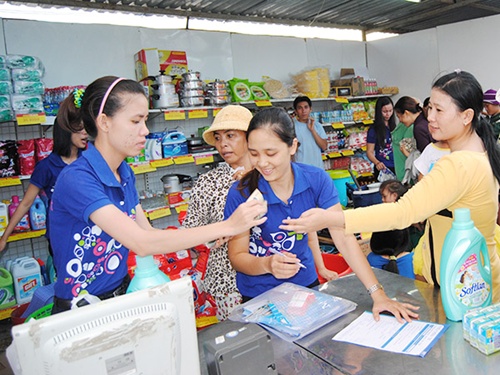Vietnamese goods struggle to compete
Vietnamese goods struggle to compete
The Vietnamese-To-Use-Vietnamese-Goods campaign plays an important role in building a consumer culture that learns to purchase Vietnamese products and manufacture more Vietnamese goods of high quality.

However, there remains many challenges in serving the local market and in exporting locally made goods. Business insiders and policy-makers have to seek solutions to handle these challenges.
It is reported that at least 80-90 per cent of Vietnamese goods are now on the shelves of many supermarkets. However, the Ministry of Trade and Industry said that distribution channels of Vietnamese goods in rural areas had not been stable and product promotion remains poor, resulting in low competition among local products.
A representative of Intimex Supermarket attributed the selling bottleneck of Vietnamese goods to poor market research and distribution channels. As a result, local consumers have difficulty accessing high-quality Vietnamese goods.
In addition, local consumers still prefer foreign trademarks, therefore, the question is what does the country do to change Vietnamese consumer habits?
Actually, Vietnamese consumers do not dislike Vietnamese goods, though they do not have enough information and often lack confidence in domestic producers.
Vu Kim Hanh, the chairwoman of the Association of High-Quality Vietnamese Goods Producers, said Vietnamese goods find it difficult to compete with goods produced in Viet Nam by multinational companies, adding that if distributors give priority to selling multinational companies' goods, Vietnamese goods will have no place in supermarkets.
Hanh said many local producers have now invested in upgrading their technology to manufacture high-quality products to meet local demands. Many of them have acknowledged the position and importance of local markets and work out strategic plans on distribution, marketing and advertising to raise their reputation and the quality of their trademarks for domestic consumers.
Le Viet Nga, Deputy Director of the Ministry of Industry and Trade's Domestic Market Department, said the ministry had proposed a scheme, known as "Viet Nam's Pride", to change consumer habits of local customers through the strengthening and diversification of communication and promotion campaigns.
This scheme has also set a target of increasing market share to at least 80–100 per cent of distribution channels in cities and provinces by 2020.
To reach this target, it required State authorised agencies, professional associations and mass media agencies to develop programmes to honour entrepreneurs, businesses, organisations and individuals who have obtained outstanding achievements in the campaign to give priority to use Vietnamese goods.
Deputy Minister of Industry and Trade Do Thang Hai said his ministry also worked closely with ministries and localities to determine market forecasts and supervise the real situation, to work out timely measures to intervene and stabilise the domestic market.
Hai also proposes the Central Steering Committee for the Campaign instruct relevant bodies and localities to continue raising awareness among the entire community about this campaign.
He said this year and next years, Viet Nam manufacturers would have to do their utmost to enhance product competitiveness against imported products of the same type. He noted that despite good communications, the quality of many products remains poor and it is often difficult to persuade consumers to purchase locally made products.
bizhub




















